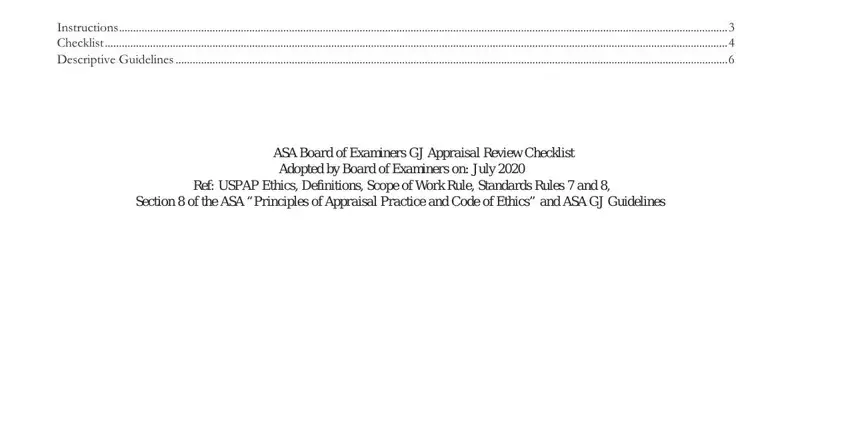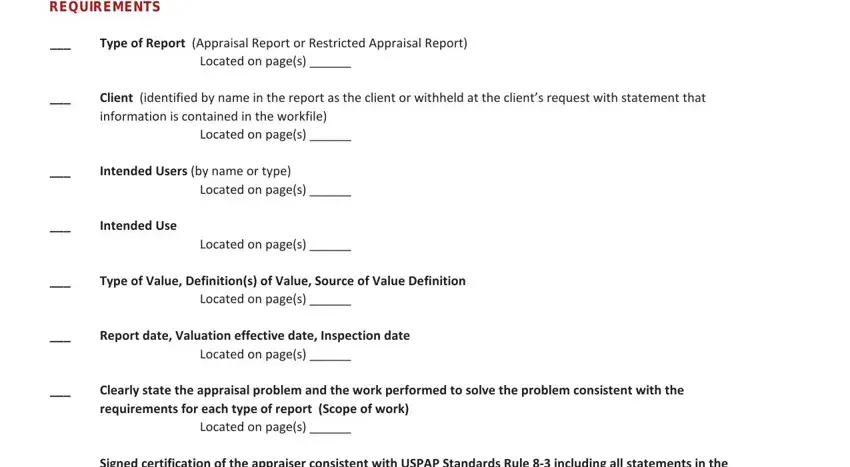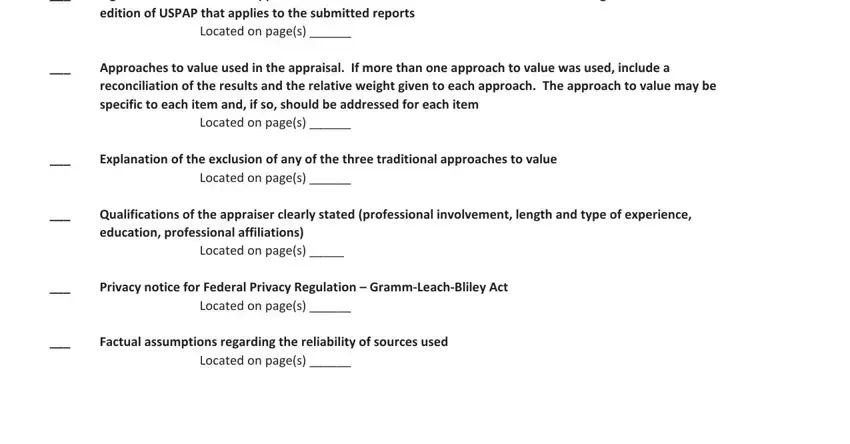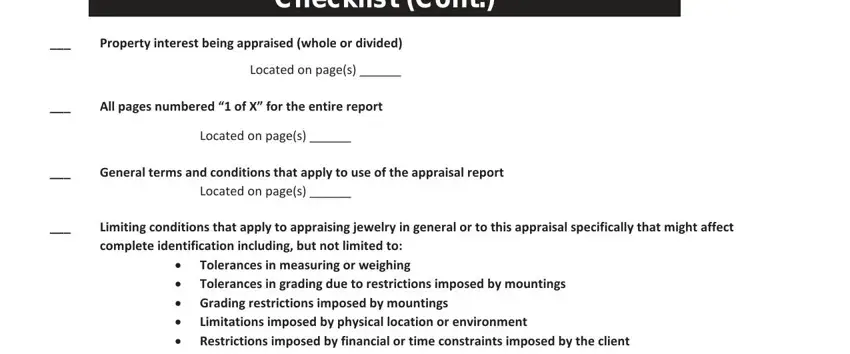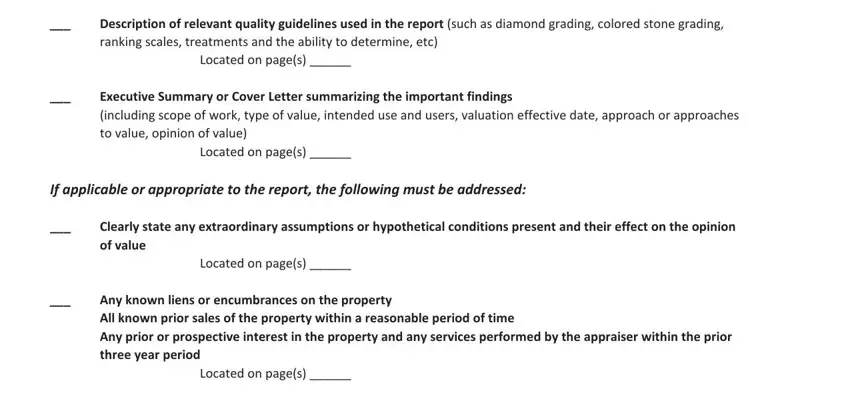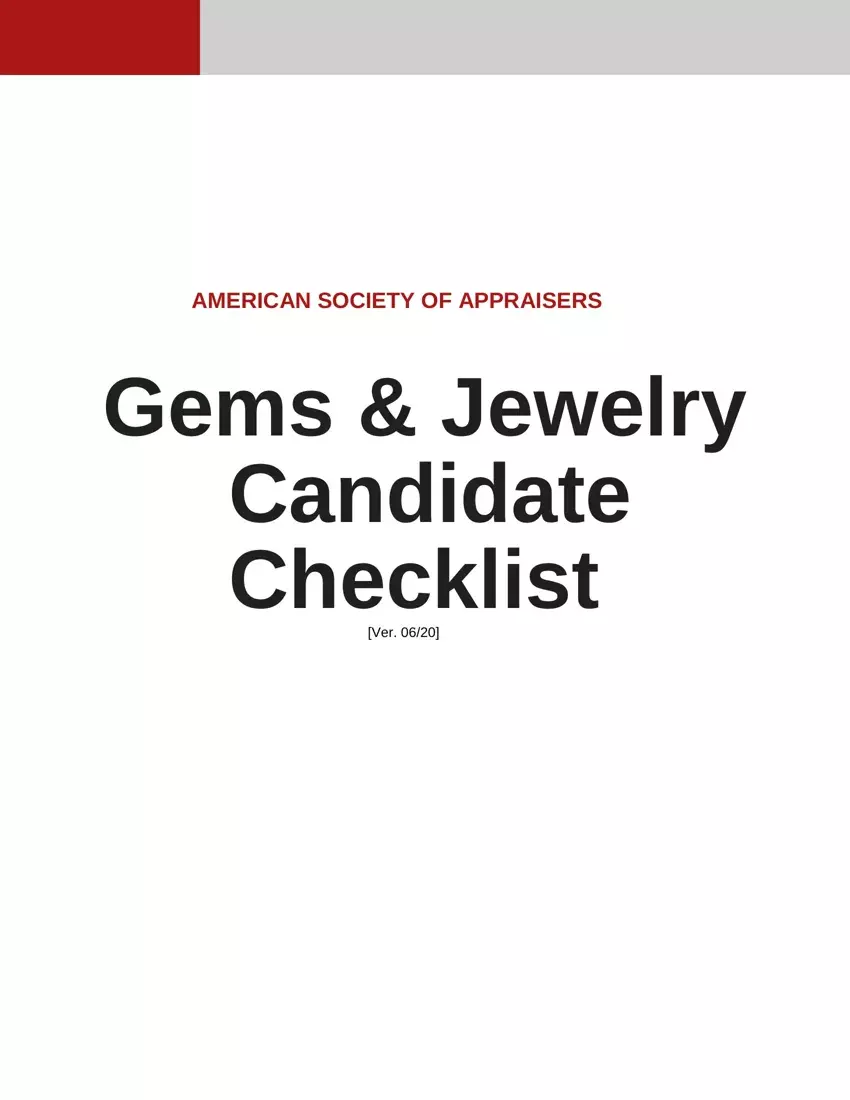AMERICAN SOCIETY OF APPRAISERS
Gems & Jewelry
Candidate
Checklist
[Ver. 06/20]
|
TABLE OF CONTENTS |
Instructions |
3 |
Checklist |
4 |
Descriptive Guidelines |
6 |
ASA Board of Examiners GJ Appraisal Review Checklist Adopted by Board of Examiners on: July 2020
Ref: USPAP Ethics, Definitions, Scope of Work Rule, Standards Rules 7 and 8, Section 8 of the ASA “Principles of Appraisal Practice and Code of Ethics” and ASA GJ Guidelines
Instructions
As part of the ASA advancement process, Candidates must submit (2) two comprehensive Appraisal Reports to the Board of Examiners for review. These reports should represent the Candidate’s best possible work product, written in a careful manner limiting errors that affect the credibility of the report (i.e. errors in spelling, grammar, calculations).
The types of reports required are:
•Intended use for scheduling insurance coverage in which the relevant market for each item is stated and the research conducted is summarized.
•Intended use in which the appropriate type of value is Fair Market Value. The relevant market and research conducted for each property must be explained. Comparables selected in arriving at an opinion of value must be included and the reconciliation of how they support the opinion of value must be explained. (In other words, what did you do and why did you do it?)
In order to demonstrate understanding of appraisal methods and ASA GJ descriptive guidelines, each report must include at least four (4) items and include:
1.A diamond greater than 0.50ct (requiring a plot);
2.A colored gemstone significant enough to warrant a gemstone report;
3.An item for which the sales comparison approach takes precedence over the cost approach (antique, vintage or designer piece, and most items when fair market value is the objective); and
4.An item of the Candidate’s choosing.
Items described in the appraisal reports must adhere to the GJ Descriptive Guidelines, which are included with this checklist.
Sufficient characteristics establishing the relative quality and condition of each piece must be included. Note manufacture,
style, age, provenance, and details of condition for each piece as applicable.
Photographs, micrographs as necessary, plots and scanned reports or documents should be included in the report.
The reports may be actual appraisals that have been submitted to a client, either with a signed waiver from the client authorizing use the report, or with all identifying client information redacted. If so, please submit a signed waiver agreement from the GJ Guide to Professional Accreditation. OR, the Candidate may compile the appropriate items from actual appraisals to satisfy the requirements of the type of report submitted. The report must be submitted with the legible name and contact information of the appraiser on appropriate letterhead.
The checklist helps Candidates to identify the minimum requirements in an Appraisal Report submitted to ASA for accreditation in the GJ discipline and must be completed and submitted with each report. These guidelines do not, nor are they intended to, dictate the format or sequence order to follow other than identifying what should be addressed in the reports. The checklist itself is specific to the ASA advancement process and is for use by Candidates and members of the ASA Board of Examiners only. It may not be used for any other purpose, or by parties outside the American Society of Appraisers.
This checklist was developed in accordance with Standards 7 and 8 of the Uniform Standards of Professional Appraisal Practice (USPAP), ASA standards and the ASA Gems and Jewelry descriptive guidelines and report-writing requirements. It will be helpful to Candidates to review USPAP standards before submitting appraisal documents for review.
Please submit a complete digital copy of each report and a completed copy of the checklist for each.
|
|
|
|
Checklist |
REQUIREMENTS |
___ |
Type of Report (Appraisal Report or Restricted Appraisal Report) |
|
Located on page(s) ______ |
___ |
Client (identified by name in the report as the client or withheld at the client’s request with statement that |
|
information is contained in the workfile) |
|
Located on page(s) ______ |
___ |
Intended Users (by name or type) |
|
Located on page(s) ______ |
___ |
Intended Use |
|
Located on page(s) ______ |
___ |
Type of Value, Definition(s) of Value, Source of Value Definition |
|
Located on page(s) ______ |
___ |
Report date, Valuation effective date, Inspection date |
|
Located on page(s) ______ |
___ |
Clearly state the appraisal problem and the work performed to solve the problem consistent with the |
|
requirements for each type of report (Scope of work) |
|
Located on page(s) ______ |
___ |
Signed certification of the appraiser consistent with USPAP Standards Rule 8-3 including all statements in the |
|
edition of USPAP that applies to the submitted reports |
|
Located on page(s) ______ |
___ |
Approaches to value used in the appraisal. If more than one approach to value was used, include a |
|
reconciliation of the results and the relative weight given to each approach. The approach to value may be |
|
specific to each item and, if so, should be addressed for each item |
|
Located on page(s) ______ |
___ |
Explanation of the exclusion of any of the three traditional approaches to value |
|
Located on page(s) ______ |
___ |
Qualifications of the appraiser clearly stated (professional involvement, length and type of experience, |
|
education, professional affiliations) |
|
Located on page(s) _____ |
___ |
Privacy notice for Federal Privacy Regulation – Gramm-Leach-Bliley Act |
|
Located on page(s) ______ |
___ |
Factual assumptions regarding the reliability of sources used |
|
Located on page(s) ______ |
|
|
|
|
Checklist (Cont.) |
___ |
Property interest being appraised (whole or divided) |
|
Located on page(s) ______ |
___ |
All pages numbered “1 of X” for the entire report |
|
Located on page(s) ______ |
___ |
General terms and conditions that apply to use of the appraisal report |
|
Located on page(s) ______ |
___ |
Limiting conditions that apply to appraising jewelry in general or to this appraisal specifically that might affect |
|
complete identification including, but not limited to: |
|
• Tolerances in measuring or weighing |
|
• Tolerances in grading due to restrictions imposed by mountings |
|
• Grading restrictions imposed by mountings |
|
• Limitations imposed by physical location or environment |
|
• Restrictions imposed by financial or time constraints imposed by the client |
___ |
Description of relevant quality guidelines used in the report (such as diamond grading, colored stone grading, |
|
ranking scales, treatments and the ability to determine, etc) |
|
Located on page(s) ______ |
___ |
Executive Summary or Cover Letter summarizing the important findings |
|
(including scope of work, type of value, intended use and users, valuation effective date, approach or approaches |
|
to value, opinion of value) |
|
Located on page(s) ______ |
If applicable or appropriate to the report, the following must be addressed:
___ |
Clearly state any extraordinary assumptions or hypothetical conditions present and their effect on the opinion |
|
of value |
|
Located on page(s) ______ |
___ |
Any known liens or encumbrances on the property |
|
All known prior sales of the property within a reasonable period of time |
|
Any prior or prospective interest in the property and any services performed by the appraiser within the prior |
|
three year period |
|
Located on page(s) ______ |
___ |
Title Page and Table of Contents may be included if appropriate |
___ |
A glossary or explanation of technical terms may be included if appropriate for the client and intended use |
|
Located on page(s) ______ |
___ |
Existing use of the property if it differs from the original use as manufactured |
|
Located on page(s) ______ |
Descriptive Guidelines
ASA Descriptive Elements for Gems and Jewelry
The following lists include elements that may be considered as descriptive/identifying and/or value characteristics. It is up to the appraiser to determine which of the descriptive elements need to be included to assure that the report is meaningful to the client and other intended users. Value characteristics should always be included in descriptions whether they add or detract from value. It is not necessary to include all descriptive elements for every item.
Descriptive Elements for Jewelry Mountings:
The level of detail is proportional to the intended use and users, type of report, the importance of the jewelry, and its impact on the overall value.
•A general description of the type of item (ring, bracelet, brooch, etc.)
•Style, motif (e.g., waterfall ring, hearts and scroll motif)
•Period of manufacture (approximate date / date range)
•Metal type, color(s) and fineness and testing method
•Weight of the item (including or excluding gemstones, straps, etc.) Include unit of measure e.g. grams, dwt, troy oz.
•Overall measurements/dimensions,
Include unit of measure (e.g. mm, inches)
•Method of manufacture (cast, die-struck, handmade, etc.)
•Finish (Florentine, satin, etc.)
•Findings (e.g., earring backs, type of clasp)
•Hallmarks, Trademarks or serial numbers, if present
•Name of the manufacturer if known or determinable and relevant to value
•Manufacturer’s style number, if present or known
•Condition of the item
•Any endowed characteristics of value that have an effect on value (provenance, rarity, celebrity ownership, etc.)
•Photographs (front, back, side, trademarks, fineness marks and/or damage.)
Descriptive Elements for Diamonds
The level of detail is proportional to the intended use and users, type of report, the importance of the jewelry, and its impact on the overall value.
Diamonds must be described and documented in GIA and/or AGS terminology. Any other system used must be explained and correlated accurately with at least one of those systems.
The appraiser should determine the origin of the diamond (natural vs. synthetic) within the limitations of standard gemological laboratory equipment. In the absence of certainty, either the services of a leading laboratory should be secured, or the uncertainty recorded in the appraisal. Any assumptions or extraordinary assumptions as to diamond identity or treatments must be prominently identified in the appraisal report.
All known diamond treatments and enhancements that are detectible by standard gemological equipment must be listed, including but not limited to laser drilling, coating, fracture filling, HPHT, etc.
All diamond descriptions must include:
•Actual, estimated, or calculated carat weight (number and total weight for melee)
•Color (state the average color for melee)
•Clarity (state the average clarity for melee)
•Shape
•Proportions (state the average quality of cut for melee)
Diamonds over 0.25 carat should also include
•Individual measurements
Diamonds over 0.50 carat should also include
•Individual measurements
•Proportion information (table size, girdle, polish, symmetry, culet)
•Plotting diagram or photomicrograph recommended for primary stone(s)
Diamonds over 1.00 carat should also include
•Individual measurements
•Detailed proportions (table size, girdle, culet); additional GIA cut grade elements for round diamonds are recommended. (crown angle, and height, star length, pavilion angle and depth, lower girdle facet length)
•Symmetry
•Polish
•Fluorescence
•Plotting diagram or photomicrograph
•Photographs of un-mounted diamonds are optional.
•Photomicrographs are recommended for documenting significant inclusions and damage.
Descriptive Elements for Colored Gemstones
The level of detail is proportional to the intended use and users, type of report, the importance of the jewelry, and its impact on the overall value.
The appraiser should determine not only the type of gemstone but whether the gemstone is natural or synthetic within the limitations of standard gemological laboratory equipment. In the absence of certainty, either the services of a leading laboratory should be secured, or the uncertainty recorded in the appraisal. Any assumptions or extraordinary assumptions as to gemstone identity or treatments must be prominently identified in the appraisal report.
Species and variety must be identified and included in the report as appropriate to the assignment.
Gemstone color must be described using a known, repeatable grading system (Gem-E- Square, World of Color, Munsell, AGL ColorScan, Gem Dialogue™, etc.)
Treatments and enhancements, where detected, must be described (heat treatment, irradiation, diffusion, dye, coating, fracture filling, etc.)
Country of origin should be included, if documented through a reputable laboratory specializing in Origin Reports and relevant.
All melee should include: average
•Shape
•Quantity
•Average measurements (random sampling OK)
•Estimated total carat weight
•Color
•Clarity
•Cut quality
•Matching
Primary colored gemstones should include
•Measurements
•Estimated or actual carat weight
•Shape
•Color
oHue o Tone
o Saturation
•Clarity
•Cut quality (average cut quality for multiple gemstones)
•Height and belly of cabochon
For significant transparent colored stones, also consider
•Bulge
•Windowing
•Extinction
•Brilliancy
•Plot diagram for inclusions or damage that may have a significant effect on the value.
•Photomicrographs are recommended for documenting significant inclusions and damage.
Additional Descriptive Elements for Gemstone Carvings (consider the impact on value):
•Carving type (e.g. cameo, intaglio, dimensional)
•Material (e.g. shell, coral, onyx)
•Quality of carving
•Artist if known
•Subject (portrait, city scene)
•Carving method
Additional Descriptive Elements for Gemstone Beads (consider the impact on value):
•Number of strands
•Length
•Knotted or unknotted
•Continuous or clasp with type and details
Additional Descriptive Elements for Phenomenal Gemstones Asterism description should include
•Centering
•Number of legs
•Sharpness
•Definition / strength
Cat’s-eye (chatoyancy) description should include
•Centering
•Sharpness
•Strength of eye
Adularescence description should include
•Centering
•Color / hue(s)
•Coverage
Change-of-color description should include
•Colors exhibited
•Degree of color change
•Type of lighting used and the reaction to each
